Developing metalworking fluids for lighweight metals
Dr. Neil Canter, Contributing Editor | TLT Feature Article March 2014
Regulations calling for improved fuel economy are creating new challenges for tribologists in the auto and aerospace industries.
KEY CONCEPTS
•
The movement toward higher fuel economy is prompting automotive producers to use higher quantities of lighter weight metals in their products.
•
Developing effective products for use in operations on lighweight metal alloys presents its own set of challenges to the metalworking fluid formulator.
•
A need exists for improved metalworking fluids and additives for each of the lighweight metal alloys.
THE MOVEMENT TOWARD HIGHER FUEL ECONOMY is impacting the formulation of new passenger car motor oils and heavy-duty diesel engine oils as was outlined in a previous TLT article (
1). The U.S. government has established a goal of increasing the existing Corporate Average Fuel Economy (CAFE) by 20 percent by 2016 and then doubling it to 54.5 miles per gallon by 2025.
Two key additives that will help improve fuel economy are friction modifiers and viscosity index (VI) improvers. On the industrial lubricant side, and in particular from a metalworking fluid perspective, the movement toward higher fuel economy is leading to greater demand for reducing the weight of automobiles through the use of lightweight metal alloys.
Metals that come to mind include lightweight steel, aluminum, magnesium and titanium alloys. According to a 2011 survey from industry consultant Ducker Worldwide in Troy, Mich., the amount of aluminum in a vehicle will increase from 327 pounds to 550 pounds in 2025 (
2). The Aluminum Association has a listing of 22, 2012 automobile models containing at least 10 percent finished aluminum by curb weight (
3).
Adding to the use of lightweight metal alloys was the announcement made in January 2014 that Ford Motor Co. is replacing about 1,000 pounds of steel in its best-selling F-150 pickup truck with 600 pounds of aluminum (
4). According to Automotive News, the F-150 outsold all other Ford models in December 2013, and the company sold more than 760,000 F-150 trucks in 2013 (
5).
As a complement to the earlier article, TLT recently contacted industry experts from the additive, formulator and end-user perspectives to get their assessment on the challenges in developing metalworking fluids for use on lightweight metals as their use is growing.
TLT contacted the following individuals:
1.
Brian Hovik, The Boeing Co.
2.
Rick Butler, Chemtool
3.
Jennifer Hix, Chrysler Group LLC
4.
Jerry Byers, Cimcool Global Industrial Fluids
5.
Chris Donaghy, Croda Inc.
6.
Pat Brutto, The Dow Chemical Co.
7.
John Hogan, The Lubrizol Corp.
8.
Gary Rodak, Machining Efficiencies Inc.
9.
Greg Dalton and Ted McClure, TribSys, LLC.
STLE-member Jennifer Hix, chemical specialist for the Chrysler Group LLC in Trenton, Mich., provides a perspective on the lightweight metal alloys preferred by her company. She says, “In the U.S., we typically use 380 Aluminum for all prismatic parts in engines and transmissions with the exception of heads that are prepared with 319 Aluminum.”
The use of lightweight alloys is not restricted to automobiles. STLE-member Brian Hovik, manufacturing engineer for the Boeing Co. in Seattle, Wash., comments on the importance of using lightweight materials in airplanes. “Lightweight metal alloys are very important because in the manufacture of airframes, weight is the enemy,” he says. “As the aircraft gets heavier, fewer payloads (cargo and/or passengers) can be safely carried. Lighter-weight alloys that exhibit the same or better strength as heavier metals are critical.”
MOST DIFFICULT ALLOYS
Hix indicates that of the aluminum-machining applications, the most difficult ones involve powdered metal valve seats and bimetal cutting. For Hovik, titanium is the most difficult followed by some of the more exotic steel alloys. He says, “The properties of titanium create machining parameters that increase the machining cost and lower the cutter life substantially when compared to aluminum. In aluminum machining, we calculate the cutting tool life in hours, whereas in titanium machining the cutting tool life is calculated in minutes.”
A metal-removal operation on a plate of titanium that is 12x12x2 inches thick is shown in Figure 1. The finished roller cam plate is seen in Figure 2.
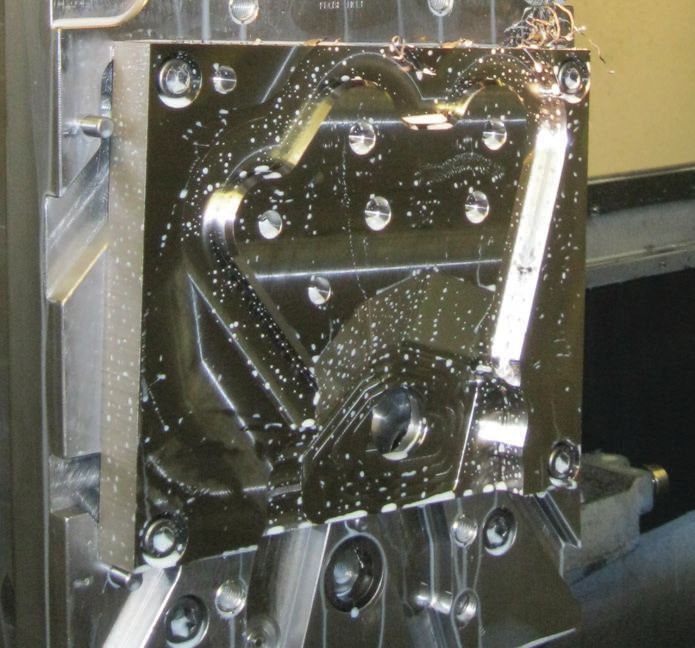 Figure 1. A metal-removal operation on a titanium plate that is 12x12x2 inches thick is shown. (Courtesy of The Boeing Co.)
Figure 1. A metal-removal operation on a titanium plate that is 12x12x2 inches thick is shown. (Courtesy of The Boeing Co.)
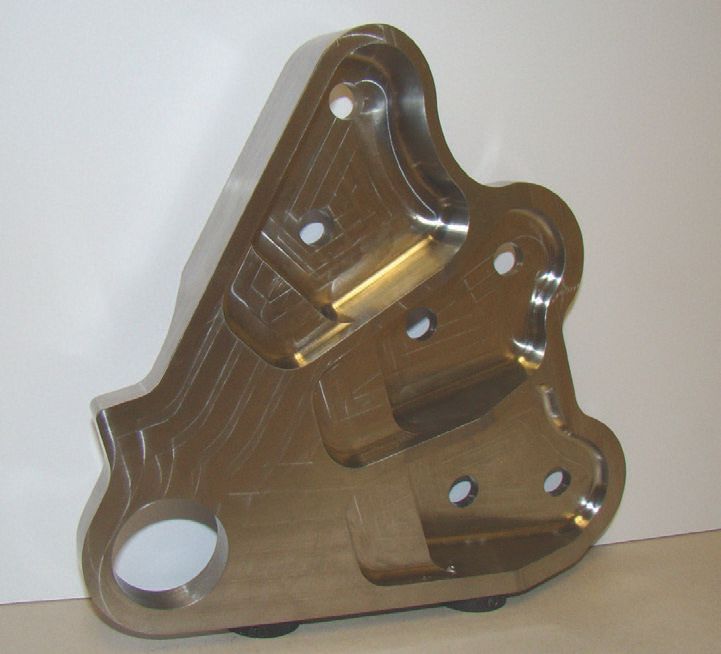 Figure 2. The finished titanium-based roller cam plate is used in aircraft applications. (Courtesy of The Boeing Co.)
Figure 2. The finished titanium-based roller cam plate is used in aircraft applications. (Courtesy of The Boeing Co.)
Hovik continues, “The machine tool equipment as well as holding fixtures must be exponentially more rigid and capable of machining forces 10 times that of conventional aluminum machining. Therefore, the economic investment required to machine titanium and the harder steels is much more than that of aluminum or magnesium machining.”
STLE-member Gary Rodak of Machining Efficiencies in Gregory, Mich., comments on differences among steel, aluminum, magnesium and titanium alloys. “Of the four types of alloys listed, magnesium and titanium pose several difficulties,” he says. “Magnesium is highly reactive with most metalworking fluids and tends to impact emulsion stability. Magnesium chips are highly flammable and burn very hot. Water will not put out a magnesium fire.”
Rodak continues by discussing titanium. “This metal is a difficult material to machine as it work hardens during the machining process,” he says. “Titanium has a higher modulus of elasticity as compared to aluminum, making it an excellent choice for aerospace applications. But this same characteristic makes titanium more difficult to machine than aluminum.”
Rodak comments further on both machining steel and aluminum alloys. “Steel alloys vary in their machinability ratings, so it is not reasonable to categorize steel alloys with a single comment,” he notes. “It depends upon the steel alloy composition and the hardness at the time of the machining process. Aluminum alloys are perhaps the easiest of these types to machine. But note that cast alloys may contain inclusions that can damage the cutting edges of tools.”
Figure 3 shows a cutting tool removing metal from an aluminum alloy.
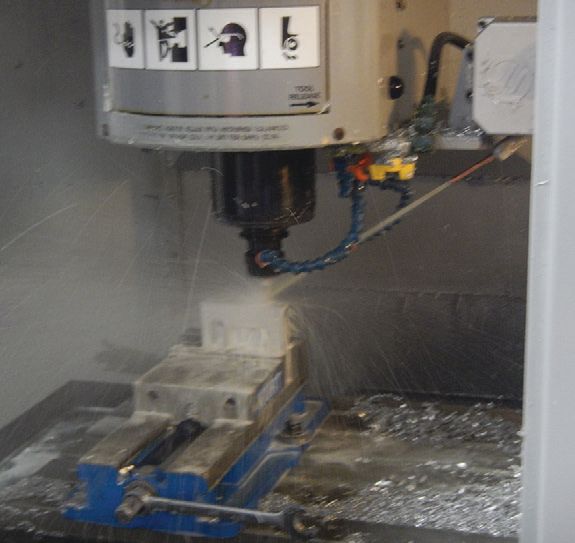 Figure 3. A metal-removal operations involving an aluminum alloy is shown. (Courtesy of Machining Efficiencies Inc.)
Figure 3. A metal-removal operations involving an aluminum alloy is shown. (Courtesy of Machining Efficiencies Inc.)
The use of lightweight metal alloys also is challenging from the metal forming standpoint. STLE-member Ted McClure of TribSys in Valparaiso, Ind., offers his perspective. “The automotive industry is under pressure to meet the 2025 CAFE standards while still continuing to excel in IIHS crash ratings,” he says. “But there is resistance to expanding usage of aluminum, magnesium and titanium alloys in automotive applications due to higher material and process costs (as compared to steel alloys) and also technical barriers.”
McClure’s associate, STLE-member Gregory Dalton, president of Trib- Sys in Coniston, Ontario, Canada, provides details on the technical challenges of using lightweight metal alloys. He says, “Lightweight initiatives for automotive bodies generally involve using thinner high-strength steels (with tensile strengths greater than 500 MPa) or by using thicker, lightweight aluminum alloys. Both of these alloys can suffer problems with ductility and edge cracking during metal-forming operations. Trimming excess material can be problematic as well, with sliver generation trimming aluminum and poor edge quality with Advanced High Strength Steels (AHSS) as these materials achieve high strength after the initial forming process.”
McClure indicates that the automotive industry is looking at finding the right type of lightweight steel alloys that provide a combination of increased strength and acceptable formability while priced competitively. He says, “Implementation of AHSS by the automotive industry is also causing increased press forces and higher die temperatures during metal forming that leads to increased wear. More energy is needed to form AHSS. Strategies undertaken to utilize AHSS and aluminum alloys include improved press control, using servo presses, roll forming, hydroforming and elevated temperature forming.”
Figure 4 shows how the properties of the major steel alloys as a function of elongation versus tensile strength. McClure says, “The Austenitic steels shown in dark orange in Figure 4 exhibit excellent properties but are not used due to their higher cost. Research is focused on developing steels in the region shown in Figure 4 that are lower cost than the Austenitics but have significantly improved properties over the AHSS grades currently available.”
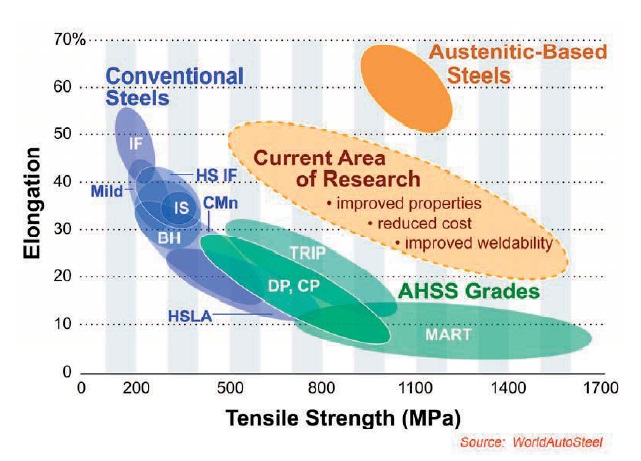 Figure 4. The characteristics of the major steel alloys are shown in this graph of elongation versus tensile strength. Research is currently underway to develop new steel alloys in the section highlighted in light orange in this graph. (Courtesy of WorldAutoSteel.Org)
Figure 4. The characteristics of the major steel alloys are shown in this graph of elongation versus tensile strength. Research is currently underway to develop new steel alloys in the section highlighted in light orange in this graph. (Courtesy of WorldAutoSteel.Org)
One area where steel alloys are being evaluated is to ensure crash ratings for automobiles can be maintained. McClure says, “Boron steel alloys are used in automotive parts requiring the maximum strength to prevent passenger compartment intrusion in crashes. These alloys are extremely strong (tensile strength of 1500 MPa) but are not very formable and not currently available in galvanized grades. The current process for working with boron steel alloys are either roll forming or press forming if required for the shape. In the latter case, the part is formed at above 850 C and then quenched in the die.”
CHALLENGES
Representatives from two metalworking fluid companies were asked to comment on the biggest challenges in machining lightweight alloys. When asked about aluminum alloys, STLE Immediate Past President Jerry Byers, manager of product development for Cimcool Fluid Technology in Cincinnati, Ohio, says, “Many of the lubricants that do a very good job cutting aluminum are foamy when formulated into a water-based metalworking fluid. An additional concern is that aluminum stains easily under the alkaline pH conditions required for metalworking fluids.”
STLE-member Rick Butler, technical manager for fluids for Chemtool, Inc., in Rockton, Ill., agrees that there are problems with preventing aluminum alloys from staining. He adds, “Effective aluminum stain controlling additives exist, but they are costly.”
Butler also is concerned that excessive tool wear is detected when working on high-silica-content cast aluminum alloys.
As mentioned previously, magnesium is a particular problem because chips produced during machining are flammable. Byers says, “Special inhibitors are needed to passivate the metal surface, and we prefer inhibitors that are not based on phosphorus chemistry.” Butler adds, “No practical magnesium corrosion inhibitors exist. Some new additives do help to some degree but come at enormous cost.”
Titanium also has its share of problems as outlined by Byers. “Titanium is a poor conductor of heat, which does not dissipate quickly during metal removal,” he says. “This means that most of the heat is concentrated on the cutting edge and the tool face. A very good cooling fluid is needed that also displays good lubrication properties. We have found that a heavy-duty synthetic works very well.”
Byers adds, “The low modulus of elasticity for titanium as compared to steel means that it is more ‘springy’ than steel, which means that the workpiece tends to move away from the cutting tool unless heavy cuts are maintained. Slender parts tend to deflect under tool pressure and can cause chatter, tool rubbing and tolerance problems. Rigidity of the entire machining system is consequently very important, as is the use of sharp, properly shaped cutting tools.”
Titanium also is prone to stress corrosion cracking, according to Byers, which is a particular concern in the aerospace industry. He adds, “Fluids should be tested to ensure they do not promote this mode of corrosion.”
Butler has not seen specific problems in working with titanium. “Semisynthetic fluids seem to provide adequate performance on titanium,” he says. “This includes experience we have had with including low amounts of inactive sulfurized additives in the formulation.”
When asked about problems with machining the AHSS alloys, Butler says, “Finding fluids to form tap, which has become more popular due to superior strength as compared to cut taps. Currently fluids have been developed with and without chlorinated additives.”
IMPROVED MWFs AND ADDITIVES
For some of the lightweight metal alloys, improvements in metalworking fluid performance were mentioned by several of the respondents. Hovik says, “The first and most important metalworking fluid property when cutting titanium and hard steels is cooling. While lubricity plays an important role, the enemy to titanium and steel cutting tooling is heat, which means that keeping cutters cool is critical. The second most important property is sump life— it matters little how well a metalworking fluid performs if it lasts only a very short time in the sump. Such inadequate performance can be extremely costly to the end-user.”
From Hix’s perspective, air entrainment is the biggest problem. She says, “The lubricity of metalworking fluids used for machining aluminum is satisfactory. But the main problem we face is air entrainment. Chrysler has moved to a complete modular computerized numerical control (CNC) setup where each CNC has its own high-pressure pump and high-velocity pump back. Unfortunately, when the fluid is sent from a transfer tank back to the main filter, the coolant settling time can be as little as two to three minutes, which is insufficient for completely purging air.”
Dalton and McClure point out that improved lubricants are needed in metal-forming operations on AHSS. McClure says, “Higher die temperatures and forces experienced in forming AHSS can change the lubricant requirements because of the need to tolerate higher temperatures and not oxidize. Without new lubricants, parts are more difficult to remove and can generate offensive odors and smoke. Other concerns that need to be minimized during the forming process are galling and die wear under these severe conditions.”
Dalton adds, “The high heat buildup in the dies and thermal softening of the workpiece lead to adhesive wear, which is a particular concern in blanking and trimming operations since it can have a negative impact on edge quality and sliver generation. Metal-forming lubricants should remove heat and flush away slivers, while additives can react with the surfaces to reduce adhesion.”
Dalton’s comments suggest that extreme-pressure additives are needed in metal forming of AHSS. McClure says, “Dry film lubricants can perform well in some operations but are limited in that they do not offer any real cooling or heat-conducting characteristics. A more generally viable option is the use of EP additives in metal-forming lubricants.”
From an inhibitor standpoint, both Butler and Byers agree that more effective inhibitors to stop magnesium chips from reacting with water are needed. Byers says, “Low-foaming lubricants and emulsifiers for aluminum also are needed. For both lighweight metals, chemistry not based on phosphorus is preferred to avoid microbial issues.”
CHLORINATED PARAFFINS
In metal forming of AHSS, the debate is underway about the suitability of using chlorinated paraffins for performance reasons. McClure says, “One reason not to use chlorinated lubricants is stain and corrosion potential. The AHSS, due to higher temperatures and pressures, likely benefit from higher chlorine content lubricants and will likely activate the additive more completely, requiring additional stain and rust inhibition. Chlorine is very effective, especially on stainless steels. Work is expected to continue on chlorine replacements for severe applications and stainless steels in the foreseeable future.”
One published study evaluated the performance of a chlorine-containing fluid and chlorine-free fluids in stainless steel tube rolling (Figure 5) (
6). McClure says, “Evaluation of potential metal-forming fluids in this severe pilgering operation can be difficult. In most cases, the end-user has to rely on running the operation with a candidate fluid to assess performance. For this study, a comparison was made between doing the stainless steel tube rolling on a mill, as is done commercially, and using the Twist Compression lab test.”
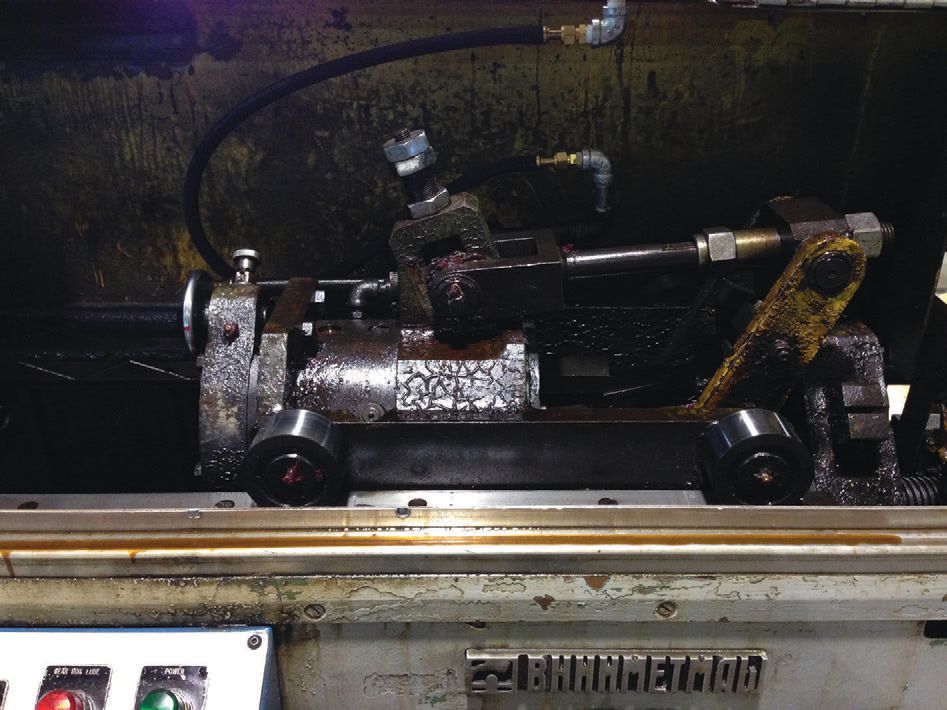 Figure 5. An early 1970s tube roller designed by The Russian Institute and Design Institute of Metallurgical Engineering is commonly used to take over 70 percent overall reduction on zirconium, stainless and Inconel tubing. (Courtesy of Superior Tube Co.)
Figure 5. An early 1970s tube roller designed by The Russian Institute and Design Institute of Metallurgical Engineering is commonly used to take over 70 percent overall reduction on zirconium, stainless and Inconel tubing. (Courtesy of Superior Tube Co.)
The result from the study was that the lab procedure could be correlated to the actual metal-forming operation. Authors of the study estimate that a cost savings of at least $70,000 can be realized along with a significant reduction in the time needed for testing by using the lab test.
Hovik indicates that environmental drivers are the key motivation for reducing use of chlorinated paraffins. He says, “Pressures from environmental entities, as well as the goal of reducing hazards in the machine shop are the primary motivation to reduce or eliminate chlorinated paraffins. Metalworking fluids that can get acceptable tool life without the need for chlorinated EP additives are desired. We are concerned with the chloride levels in the waste oil that we must dispose of. Chlorinated coolants do contribute to higher chloride levels in waste oil, which translates to higher disposal costs and/or disqualification from recycling or rerefining the waste oil.”
Hix is not aware that her company is using any metalworking fluids formulated with chlorinated paraffins. She says, “I have researched the issue and found that we have no restrictions on the use of chlorinated paraffins.”
From the metalworking fluid formulator perspective, Byers says, “We already have many chlorine-free products available for use on aluminum, magnesium and titanium.” Butler adds, “For the most part, in machining aluminum alloys we have already transitioned to non-chlorinated chemistries. Very few lighweight alloy applications cannot be done without chlorine. Sometime field trial and approval is required for non-chlorinecontaining fluids. No single chlorine replacement works in all cases. We seriously look at all chlorine replacements at all times.”
ADDITIVE SOLUTIONS
Input on the types of additives that can be used in formulating metalworking fluids for use on lighweight metals focused on the selection of boundary lubricity additives such as esters. STLEmember John Hogan, metalworking additive technical service manager for The Lubrizol Corp., in Wickliffe, Ohio, comments on what to do to formulate fluids for use on the lighweight steel alloys.
“Our understanding is that forming AHSS and advanced ultra-high strength steel (A-UHSS) causes difficulties such as springback and edge cracking,” Hogan says. “Manufacturers are trying a number of mechanical/ processing solutions for these forming challenges, which are attributed in part to the lower elongation properties with the advanced steels compared to mild steel. Additives that provide boundary lubrication and increase film strength are applicable to AHSS due to the higher contact forces compared to mild steel.”
In working with aluminum, STLE-member Chris Donaghy, sales directorpolymer additives and lubricants for Croda Inc. in New Castle, Del., discusses the use of a unique lubricity/ emulsifier that is a polymerized fatty acid (POLFA) derivative. He says, “This POLA-based lubricity additive demonstrates cutting efficiency benefits on 6061 aluminum when used in a formulation as compared to industry standard fluids.”
Figure 6 shows the results for a microtap test, which evaluated the POLFA derivative versus three commercial metalworking fluids in the microtap test. Commercial C is a premium, high-oil semisynthetic fluid that was chosen as the reference and arbitrarily given a cutting efficiency of 100 percent.
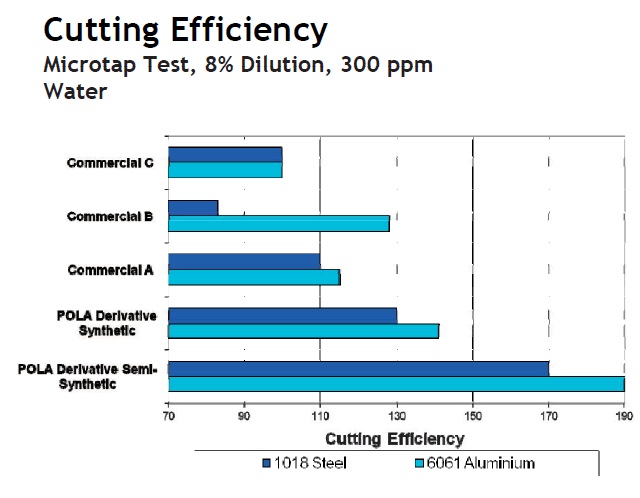 Figure 6. Microtap test data shows that a POLA derivative can improve the performance of both a semisynthetic and synthetic fluid on aluminum and steel alloys. (Courtesy of Croda Inc.)
Figure 6. Microtap test data shows that a POLA derivative can improve the performance of both a semisynthetic and synthetic fluid on aluminum and steel alloys. (Courtesy of Croda Inc.)
Donaghy says, “We found that the POLA derivative used as the base for a synthetic fluid displayed strong performance on both 6061 aluminum and 1018 steel. The performance increased significantly when mineral oil was added and a semisynthetic fluid prepared. For the POLA derivative to provide maximum benefit, it needs to be used not as a top treat additive but, rather, as the base of a new formulation.”
Hogan states that there are several options that can be used in machining wrought and cast aluminum alloys. “Synthetic esters, natural esters and phosphate esters are commonly employed to enhance lubrication performance for a wide variety of aluminum alloys. Most often emulsifiable oils or semisynthetic fluids are used for machining aluminum. Traditional synthetic fluids have had limited success in machining aluminum, although recent advances in self-emulsifying ester technology are enabling the use of synthetic fluids as a viable option for the metalworking fluid formulator.”
While the use of new types of boundary lubricity additives can improve metalworking fluid performance in working on aluminum, some secondary concerns need to be addressed. Hogan says, “In addition to formulating for enhanced lubricity for good surface finish, aluminum machining fluids may require different wetting component characteristics due to the surface energy difference compared to ferrous metals.
“Additionally,” he adds, “emulsifier systems should be optimized to prevent the formation of insoluble aluminum soaps or at least keep these soaps dispersed to prevent tacky residues.”
Staining of aluminum alloys is of particular concern at the high pH values where metalworking fluids are formulated. Hogan says, “Low pH fluids can be desirable to reduce the potential for aluminum corrosion, however this can compromise corrosion protection for the machine tool itself, as well as make a less hostile environment for microbes.”
STLE-member Patrick Brutto, technical service & development for Dow Consumer & Industrial Solutions in Buffalo Grove, Ill., maintains that certain amines used in metalworking fluids may be partially responsible for staining aluminum. He says, “Instead of formulating at low pH, stain inhibitors such as phosphate salts and esters can be used in metalworking fluids to minimize staining at higher pH values. However, these inhibitors are not effective with all alloys and can create problems such as biological growth and foaming (phosphorus compounds) and plugging of ultrafiltration membranes (silicates). A better alternative is to address the root cause of the problem, which is often the amine components.”
Brutto continues, “Certain amines such as monoethanolamine (MEA) are more prone to attack aluminum. Relatively high levels of triethanolamine (TEA) are sometimes used to provide reserve alkalinity, but this can also contribute to staining problems. Re- placement with less aggressive products and reduction of the total amine content is often beneficial. If microbiological control is maintained, there is less need for high-reserve alkalinity. Replacing high levels of TEA, which supports microbiological growth, with lower levels of less aggressive, long-life amines can make a more aluminum-friendly fluid. It is possible to do this even at pH 9.5, as long as the correct amines are selected and the total alkalinity is minimized.”
An example of a long-life amine is 3-amino- 4-octanol. Brutto says, “This amine is excellent for long-life fluids when used in combination with most registered antimicrobial pesticides. It is less aggressive on aluminum alloys than many other amines and is low foaming. In addition, 3-amino-4-octanol is registered in most major economies and is readily biodegradable in the environment.”
Figure 7 shows the tendency for three metalworking fluid formulations to stain four common aluminum alloys. All of the metal coupons were half immersed in 5 percent dilutions of the three fluids. A good deal of staining was seen in Fluid No. 1, which was formulated with MEA and TEA. Fluids Nos. 2 and 3 were formulated with MEA, lower levels of TEA and 3-amino- 4-octanol. Fluids Nos. 2 and 3 are much less aggressive towards these alloys, even though their pH values are slightly higher (9.3) than that for Fluid No. 1 (9.1).
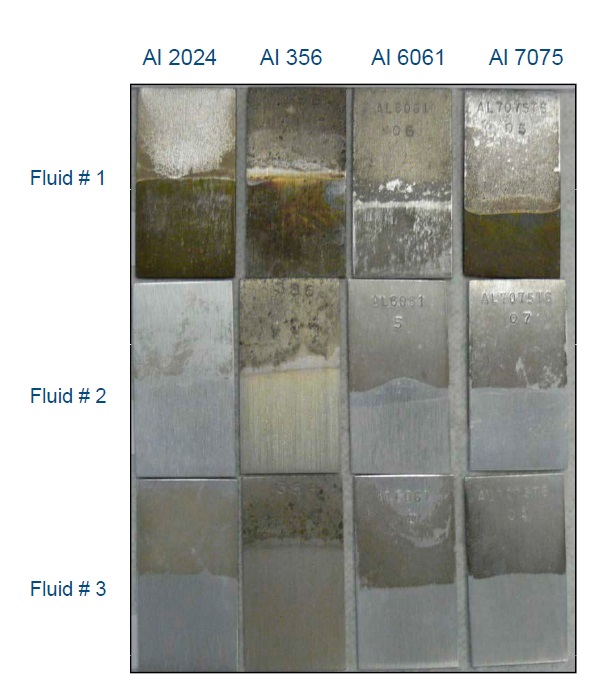 Figure 7. An evaluation of the tendency for three fluids to stain four common aluminum alloys is shown. Fluids 2 and 3 are formulated with MEA, 3-amino-4-octanol and lower levels of TEA than what is used in Fluid 1, which also contains MEA. (Courtesy of Dow Consumer & Industrial Solutions)
Figure 7. An evaluation of the tendency for three fluids to stain four common aluminum alloys is shown. Fluids 2 and 3 are formulated with MEA, 3-amino-4-octanol and lower levels of TEA than what is used in Fluid 1, which also contains MEA. (Courtesy of Dow Consumer & Industrial Solutions)
Hogan points out several characteristics needed to ensure success in working with magnesium alloys. “Corrosion inhibitors have been specifically designed to mitigate the reaction between magnesium and water and the related staining and hydrogen gas generation. Additionally, robust buffering systems and extreme hard water stability are required in these systems to achieve good sump life.”
In working with titanium, a multiadditive approach is desired. Hogan says, “When machining titanium, polymeric esters and phosphate esters have been used in water-extendable fluids to improve surface finish and tool life. Polymeric esters, sulfurized EP additives and overbased sulfonates have been used in various combinations in neat oils for even severe applications such as pilgering titanium tubes.”
CL PARAFFIN ALTERNATIVES & MULTIMETAL SOLUTIONS
Developing alternatives to chlorinated paraffins has been a goal for many years. The growing use of lighweight metal alloys has led to the potential use of a number of non-chlorinated additive options.
Hogan says, “Formulators have successfully replaced chlorinated paraffins in a wide variety of metalworking applications with additives such as polymeric esters, phosphorus compounds, sulfurized EP additives and overbased sulfonate chemistries. These alternate chemistries have been successfully used, even on demanding metalworking applications such as tapping inconel and stainless steels. Stainless steels can be technically challenging in some of the most demanding applications such as deep drawing, due to the low surface reactivity with nonchlorinated EP agents. The additive industry continues to research new and optimized chemistries to enable cost-effective replacement of chlorinated additives.”
POLA-based derivatives and biobased boundary lubricity additives have been evaluated as alternatives to chlorinated paraffin in metal-forming applications. Donaghy says, “We have found good performance with these additives as compared to chlorinated paraffin at equivalent treat rates in the Twist Compression Test (
see Figure 8).”The additives used in the Twist Compression study were evaluated at a 10 percent treat rate in mineral oil on an aluminum alloy. A lower friction factor was seen with a biobased boundary lubricity additive.
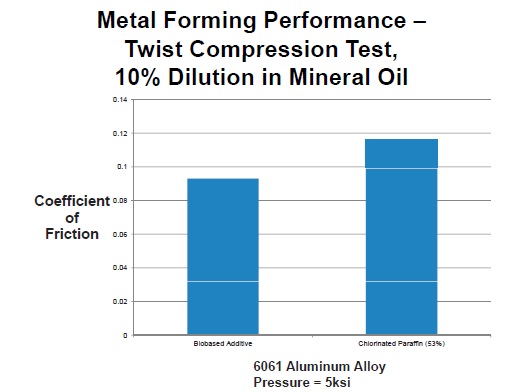 Figure 8. A fluid formulated with 10 percent of a biobased boundary lubricity additive displays a superior coefficient of friction than a fluid formulated with 10 percent chlorinated paraffin in the Twist Compression Test run on a common aluminum alloy. (Courtesy of Croda Inc.)
Figure 8. A fluid formulated with 10 percent of a biobased boundary lubricity additive displays a superior coefficient of friction than a fluid formulated with 10 percent chlorinated paraffin in the Twist Compression Test run on a common aluminum alloy. (Courtesy of Croda Inc.)
The growing use of lighweight metal alloys is also leading to end-users requesting metalworking fluids that can operate effectively on multiple metal alloys. One example of a successful approach was shown in Figure 6 using a POLA derivative. Donaghy says, “When we run comparative testing, the concentration of actives in the formulation with the POLA derivative (refractometer reading) is ALWAYS less than the comparison fluid.”
As indicated by Hogan, multiple metal-alloy applications usually require at least the use of an ester-based boundary lubricity additive that can be combined with phosphate esters to enhance performance. Hogan says, “This strategy can be optimized by the selection of multifunctional additives. For example, certain esters not only provide lubrication performance but also can contribute to emulsification properties and rust protection. Phosphorus- based aluminum stain inhibitors can act not only for their primary function but also contribute to EP properties and hard water stability.”
He continues, “In neat oils, esters have been commonly used, either alone or in combination with EP additives. Often, a sulfurized additive is required to achieve the necessary performance for difficult ferrous applications, but it must be non-staining for yellow metals. Ester-based neat oils are gaining popularity as often the need for EP additives has decreased.”
Metalworking fluid formulators find value in being able to use one fluid to work in multimetal applications. Butler says, “This is a huge topic because the automotive industry in the 1980s started to replace cast iron and steel components with difficult-to-machine cast aluminum. This trend is just now starting to occur in heavyduty diesel equipment. The ability to machine both ferrous and aluminum alloys with the same metalworking fluid is expected, not desired. As a general rule, non-chlorinated metalworking fluids designed for aluminum alloys will usually work on cast iron and steel alloys.”
Byers says, “Manufacturers want the flexibility of having one metalworking fluid that can be used in a wide range of operations on different metals, so interest in such fluids and additives is high.”
TESTING APPROACHES
Hovik looks at how the metalworking fluid performs on basic machinability tests. He says, “We examine metalworking fluids using the IWIG test performed at TechSolve that compares different fluids to a base fluid with a standard process. The objective is to create data showing how one fluid shows improvement in cutter life.”
Hix is focused on testing metalworking fluids for air entrainment. She says, “We are looking for lower entrained air volume measured at one, three and five minutes.”
Dalton and McClure see value in using the Twist Compression Test to evaluate lubricants for lighweight metal alloys and AHSS. Dalton says, “In most cases, workpiece adhesion to the metal-forming die is caused by lubricant starvation under high pressure. Performance data should be generated using a tribotest capable of achieving this condition and activation of EP additives.”
Dalton indicates that the automotive standard tribotest has been the draw bead simulator, but there are problems with using this technique. “With the implementation of AHSS, there are issues with the ability of the draw bead simulator to handle the forces, without breaking, as well as bead-wrap or contact area problems at full penetration,” he says. “The Twist Compression Test is a surface test, and the bulk sheet is not deformed, avoiding these issues.”
Rodak believes in doing bench comparison testing of various metalworking fluids but is not certain that the field result will validate the superiority of one of the products tested. He says, “There is no magic elixir that will come out of a drum that can fix fundamental machining or process design errors. Selection of a metalworking fluid is a series of compromises with the known critical performance characteristics high on the no-compromise list. Improving the performance of a fluid for a specific operation is possible only if the fundamental elements of manufacturing are correct. If a dramatic change in the fluid does not reap any appreciable change in the machining process, it can be said that the process is insensitive to the coolant. That means there is a stronger control factor in the machining process or, more common, several stronger factors in play.”
In looking for additives to use in lighweight metal and multimetal alloy applications, Byers is requesting data based on the type of additive. He says, “In the case of esters, some indication of good hydrolytic stability is helpful. For phosphorus-based additives, some bioresistance testing is important.”
In general, Byers is seeking actual metal-cutting data such as tapping torque and corrosion-inhibition data. Butler’s request is focused on data showing how specific additives perform with magnesium alloys.
The push for better fuel economy will certainly lead to greater use of lighweight metal alloys. Metalworking fluid additive suppliers and formulators will need to develop new approaches to enable end-users to maximize performance, not just on a specific lighweight alloy but also on multimetal alloys.
REFERENCES
1.
Canter, N. (2013), “Fuel economy: The role of friction modifiers and VI improvers,” TLT,
69 (9), pp. 14-27.
2.
Click
here.
3.
Click
here.
4.
Click
here.
5.
Click
here.
6.
Brooks, J., McClure, T. and Nagele, C. (2013), “Qualification of Chlorine-containing and Chlorine-free Stainless Steel Tube Rolling Lubricants through Bench (Twist Compression) and Mill Testing: A Case Study,
Presented at the STLE 68th Annual Meeting, Detroit, Mich., May 8-11.
 Neil Canter heads his own consulting company, Chemical Solutions, in Willow Grove, Pa. You can reach him at neilcanter@comcast.net
Neil Canter heads his own consulting company, Chemical Solutions, in Willow Grove, Pa. You can reach him at neilcanter@comcast.net.